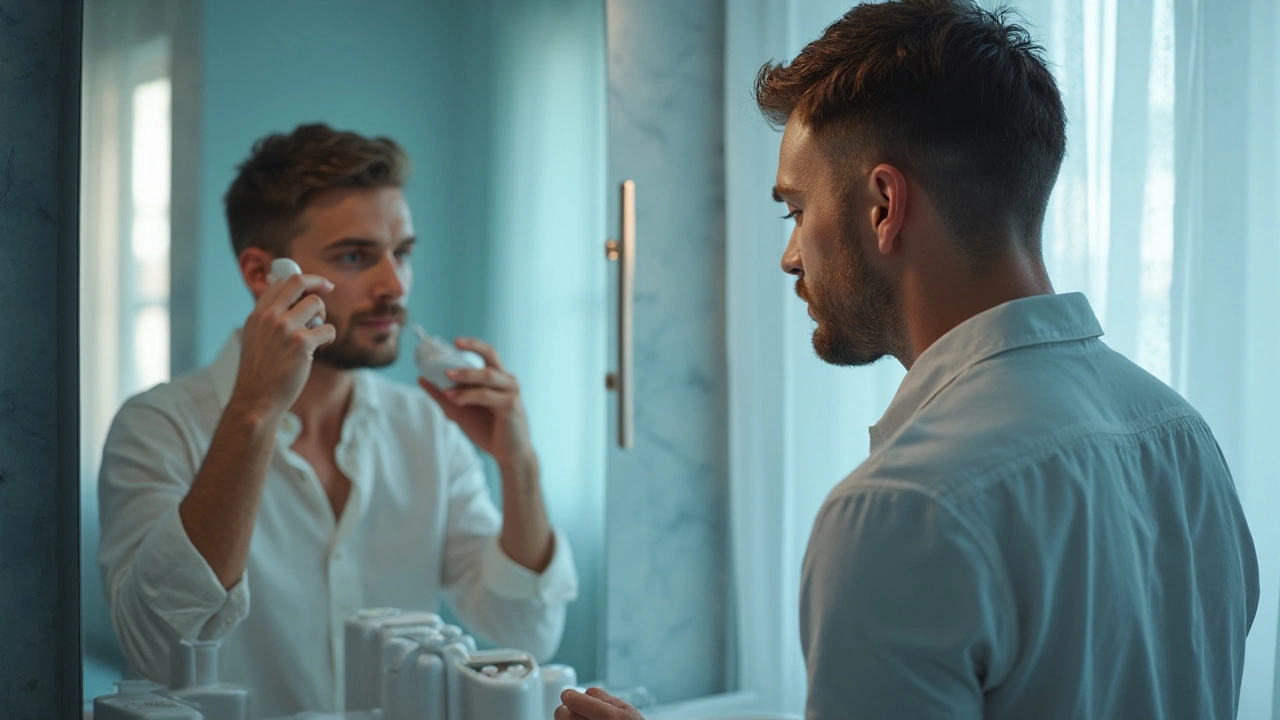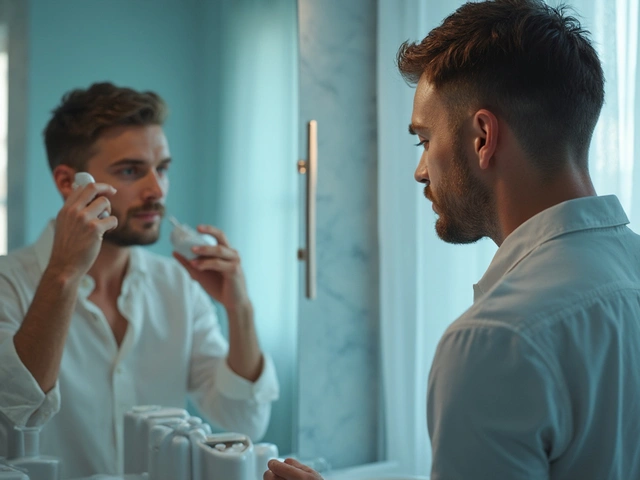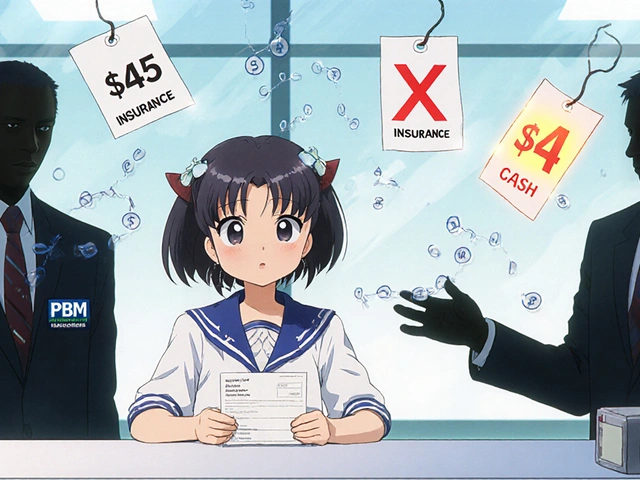Popping a Propecia pill isn't the only way to deal with thinning hair. A lot of guys don’t even want to mess with the side effects. Good news: there are other options out there—some are old-school, some are straight out of a sci-fi movie. If you’re trying to keep (or bring back) some hair, knowing what actually works is half the battle. This rundown breaks down the alternatives, giving you the real facts about what’s effective, what isn’t, and what sort of commitment you’re in for.
Remember, hair loss is common. You’re not alone—millions of us are figuring out what to put on our scalp (or plug in by the bed) in hopes of thicker, fuller hair. Let’s get into what these Propecia alternatives can actually do for you, without the fluff.
- Minoxidil
- Dutasteride
- Low-Level Laser Therapy (LLLT)
- PRP Therapy
- Hair Transplant Surgery
- Natural Supplements
- Which To Choose? (Comparison Table)
Minoxidil
You’ve probably seen Minoxidil in every drugstore. It’s that foam or liquid you rub into your scalp for hair loss. Unlike Propecia alternatives you swallow, this one goes straight onto your scalp. Minoxidil is FDA-approved for both men and women, and it’s been around for decades. Think of it as a classic move in the hair loss treatments playbook.
Originally, Minoxidil was used to treat high blood pressure—but doctors noticed people started growing hair where they didn’t expect. Enter the 2% and 5% Minoxidil we see everywhere now (brands like Rogaine). Research shows it can help slow down hair loss and, in some people, even regrow some hair—especially if you start early. If your hairline is receding or your crown is thinning, this stuff usually works best for those who stick with it long-term.
Here’s the catch: you need to apply it daily, and if you stop, any new hair growth will likely fade away. Most guys will see some results after 3 to 6 months, but it’s not a miracle fix.
Pros
- Easy to buy at most pharmacies, no prescription needed.
- Backed by years of clinical studies and real-world use.
- Works for many with both early and moderate hair thinning.
- Simple to use—just foam or liquid, no needles or pills.
- Compatible with other hair loss treatments like LLLT or finasteride.
Cons
- Needs ongoing application—miss a few weeks, and results might reverse.
- Some guys get scalp irritation, itching, or unwanted facial hair growth.
- Less effective at regrowing hair on totally bald spots.
- Can take several months to notice visible changes.
- Stopping treatment usually means losing any gains.
For people who like numbers, about 40-60% of men get at least some benefit from Minoxidil. It’s not a silver bullet, but it’s usually the go-to starting point for hair loss treatments.
| Category | Minoxidil |
|---|---|
| Type | Topical (foam/liquid) |
| FDA Approval | Yes |
| Prescription Needed | No |
| Who Can Use It? | Men & Women |
| Typical Wait for Results | 3-6 months |
Dutasteride
If you’ve looked into Propecia alternatives, you’ve probably seen Dutasteride pop up. It’s actually a stronger cousin to finasteride (the key drug in Propecia). While Propecia blocks one type of enzyme that creates DHT—the hormone behind male pattern baldness—Dutasteride blocks two. That means it can lower DHT even more, often by over 90%. Shaving off that much DHT can slow hair loss and, sometimes, even bring dormant hair back to life.
It’s officially approved for treating enlarged prostates, not hair loss, at least in the US. That hasn’t stopped a ton of doctors from prescribing it ‘off-label’ to men fed up with standard treatments. Dermatologist Dr. Jerry Shapiro from NYU Langone Health put it bluntly:
“In terms of hair regrowth, Dutasteride can be more effective than finasteride—but it may also have a higher risk of side effects.”
What sort of side effects? Think low libido, *sometimes* erectile dysfunction, or a lower sperm count, though not everyone gets these. Like Propecia, you need to stick with Dutasteride if you want results—quitting means any new growth probably falls out over a few months.
| Drug | Average DHT Blocked | Approved for Hair Loss? |
|---|---|---|
| Finasteride (Propecia) | ~70% | Yes (men) |
| Dutasteride | ~90%+ | No (off-label use) |
Pros
- Blocks more DHT than Propecia, so it can be more effective for some guys with stubborn hair loss
- One pill a day—simple routine
- Generic versions are usually affordable
Cons
- Long-term safety for hair loss isn’t as well-studied as Propecia
- Higher risk of sexual side effects compared to Propecia
- Officially only approved for prostate issues, not hair, in most places
- Women—especially if pregnant—should avoid even touching broken pills (Dutasteride can cause birth defects)
If you talk to your doctor about Dutasteride, ask how it compares to other hair loss treatments. For some guys, it’s a game-changer. For others, side effects are a dealbreaker. Bottom line: it’s powerful, but not a magic bullet.
Low-Level Laser Therapy (LLLT)
If you want to dodge meds like Propecia alternatives and prefer gadgets, Low-Level Laser Therapy (LLLT) might catch your interest. This treatment is FDA-cleared, and it’s actually not new—doctors have studied laser therapy for hair loss for over a decade. The idea is simple: low-level lasers or LED devices (think helmets, combs, or caps) beam red light at your scalp. The light soaks into your skin and supposedly boosts the activity in your hair follicles.
LLLT is mostly for guys in the early stages of balding or thinning. Studies have shown that steady use—usually three times a week for 20 minutes—can improve both hair thickness and density. Devices you buy for home use are safe and painless, which is a big plus if you dread needles or prescriptions.
Here’s a quick look at device types and an average price range:
| Device Type | Typical Price (USD) |
|---|---|
| LLLT Helmet | $600 - $1,200 |
| LLLT Cap | $300 - $900 |
| Laser Comb/Brush | $150 - $500 |
Some people see results within four to six months—usually thicker hair and less shedding. But don’t expect miracles if your head’s been bald for years. LLLT works best if you catch hair loss early and stick with treatment. Some guys pair it with minoxidil for extra punch.
Pros
- Non-invasive—no needles, no drugs to swallow.
- FDA-cleared for safety at home.
- Works well if you’re just starting to notice thinning.
- You can use it alongside other hair loss treatments (minoxidil, natural supplements, etc.)
Cons
- You have to use it consistently—several times a week, or it won’t do much.
- The gear is spendy up front, especially if you want a helmet instead of a brush.
- Results come gradually—not a quick fix—and it won’t create miracles on totally bald areas.
If you’re into gadgets and can commit to a routine, LLLT could be a solid addition to your Propecia alternatives lineup.

PRP Therapy
PRP Therapy is one of those hair loss treatments that combines old-fashioned blood work with modern hair loss treatments. PRP stands for Platelet-Rich Plasma. The process is actually pretty straightforward: a doctor draws some of your blood, spins it in a centrifuge to separate the parts, then injects the plasma (packed with growth factors) straight into your scalp where hair is thinning.
Why does this work? The growth factors in plasma are meant to wake up sleepy hair follicles and nudge them into growing thicker, stronger hair. Some research, including clinic studies published since 2020, suggests that PRP can reduce hair shedding and increase hair count, especially if you catch your hair loss early.
The session takes about 30-60 minutes, and most people need a series of treatments—often once a month for three months, then maintenance shots every 3-6 months after. In clinics, PRP is usually combined with microneedling for an extra kick. It can be paired with other Propecia alternatives like minoxidil or LLLT.
It’s not magic, but some folks see visible thickening around 3-6 months in. Results can vary based on your genetics and how soon you start.
Pros
- Autologous (it’s your own blood), so there’s almost zero allergy risk
- Minimal downtime—most people head back to work the same day
- Targets thinning areas directly, which can make results more noticeable
- Can be combined with other treatments for better results
Cons
- Multiple visits are needed—one shot won’t do it
- Can be costly (a session can run $400-$1,000, and insurance won’t cover it)
- Results aren’t guaranteed, especially if you start with advanced hair loss
- There may be mild pain, swelling, or bruising afterward
Here’s a quick look at what real PRP results can look like:
| Number of Sessions | Average Increase in Hair Density | Time to See Results |
|---|---|---|
| 3 | +20% | 3-4 months |
| 6 | +35% | 6 months |
If you hate pills and want to avoid daily hassle, PRP might be worth considering alongside other Propecia alternatives.
Hair Transplant Surgery
When people want a sure bet for restoring real hair, hair transplant surgery is the heavyweight on the list of Propecia alternatives. Modern hair transplants aren’t the awkward “plug” sessions your uncle talked about. Today, doctors use precise tools to move your own hair—usually from the back of your scalp—to where you’re thinning.
The top two methods are FUE (follicular unit extraction) and FUT (follicular unit transplantation). FUE means the surgeon takes individual hair follicles and plants them directly into thinning spots. FUT takes a strip of scalp (don’t worry, they close it up and you barely see it later) and then moves bunches of follicles at once. No, it’s not like a toupee. It’s your actual hair, just rearranged by a pro.
This option is pretty high up on the price scale, but the results are usually permanent if you’ve got a good doctor. According to the American Society of Plastic Surgeons, the average transplant in the U.S. runs around $4,000–$15,000, depending on how much area you want covered and the method you choose. The surgery is done with numbing meds, so it’s not a “hospital stay” thing—you walk in and walk out. Recovery can take about a week for the scabs and swelling to go down. Full results kick in after 6–12 months, as the new hairs settle in and start to grow.
| Hair Transplant Stat | What It Means |
|---|---|
| Success rate | Up to 90% of transplanted hairs keep growing |
| Usual downtime | 3–7 days |
| Permanent? | Yes, if you have enough healthy donor hair |
Surgery isn’t for everybody. You’ll want a good supply of hair on the back or sides of the head for the doc to work with. If your loss is widespread, you might not have enough donor hair. It’s also not an instant fix—there’s patience involved. On the plus side, you won’t need daily pills or treatments afterward.
Pros
- Permanent, natural-looking results using your own hair
- One-time procedure—no daily upkeep
- Works even if large patches are thinning
Cons
- Expensive upfront cost
- Requires minor surgery and a bit of downtime
- Possible scarring with some techniques (FUT)
- Not suitable for everyone—need enough donor hair
If you want a low-maintenance, lasting solution (and you’re not squeamish about minor surgery), this might be the go-to alternative for keeping your hair for years to come.
Natural Supplements
When it comes to Propecia alternatives, natural supplements are usually the first stop for people who want something easy and low-risk. You see them everywhere—Amazon shelves, YouTube ads, every other post on Instagram. The idea is simple: certain vitamins, herbs, and minerals might help hair grow thicker or slow down hair loss. The real question is, do they actually work?
The most common players include biotin, saw palmetto, pumpkin seed oil, zinc, and collagen. Out of these, saw palmetto probably gets the most hype. It’s thought to block DHT, the same hormone that causes male pattern baldness. There’s some small-scale research showing saw palmetto can slow hair loss, but don’t expect Hollywood hair overnight. Biotin is another classic. It’s all over the labels, but unless you’re seriously lacking it, piling on biotin probably won’t do much for thicker hair.
Zinc and iron help if you’re genuinely low in them. A simple blood test can actually tell you if you need a boost. Collagen gets more attention now for hair and skin, but there’s little hard proof it directly changes hair density. Pumpkin seed oil has a couple of tiny studies backing it, saying it could help, but honestly, the results weren’t dramatic.
If you want to give supplements a shot, look for the right dose on the label. More isn’t always better, especially with things like zinc (too much can make you sick). And keep your expectations real—these aren’t magic pills.
- Minoxidil works at your scalp. Supplements mostly work systemically.
- Natural supplements can sometimes combine well with treatments like LLLT or topical solutions, but check with your doctor if you’re mixing stuff, especially if you take meds.
| Supplement | Main Claimed Benefit | Evidence Quality |
|---|---|---|
| Saw Palmetto | Blocks DHT | Moderate |
| Biotin | Supports Keratin | Low (except if deficient) |
| Zinc | Helps Growth Cycle | Moderate (if deficient) |
| Pumpkin Seed Oil | May inhibit DHT | Very Low |
| Collagen | Improves Hair Structure | Low |
Bottom line: natural supplements are fine if you want the most hands-off approach, but don’t expect miracles. They can make a difference if your hair loss is tied to a deficiency, but they’re not going to beat prescription products or clinical treatments. For some guys, though, it’s a good first move—especially if you just want to see if a few simple changes help before getting into the serious stuff.

Which To Choose? (Comparison Table)
If deciding between Propecia alternatives has you spinning, you’re not alone. Some work faster, some are easier to stick with, others cost way more. What matters is picking the one that makes sense for your wallet, your lifestyle, and how much hair you want to keep (or get back).
Honestly, what works for your buddy might not work for you. For example, about two-thirds of men can expect to keep their hair stable with finasteride or dutasteride long-term, but side effects—especially sexual—drive a lot of guys to try other stuff. Minoxidil is dirt cheap and super easy, but expect some mess and a slow climb. Laser helmets like LLLT look wild, but there's legit FDA clearance backing them for early hair loss. PRP and transplants? You’ll shell out serious cash, but they give visible, lasting results.
Let’s lay all that out side by side. Here’s a quick crash course with the heavy hitters lined up in a no-nonsense table:
| Treatment | How It Works | Best For | Cost Range | Pros | Cons |
|---|---|---|---|---|---|
| Minoxidil | Topical liquid/foam boosts blood flow, reactivates follicles | Most types of male pattern hair loss | $10–30/month | Cheap, simple, OTC, works for lots of guys | Ongoing use, messy, sometimes itchy scalp |
| Dutasteride | Oral pill blocks more DHT than Propecia | Stubborn, advanced hair loss | $40–100/month (brand/generic) | Even stronger than finasteride, once-daily pill | Higher risk of sexual side effects, script needed |
| LLLT | Low-level lasers stimulate follicles (helmet/cap) | Early-stage hair loss or combo treatment | $200–900 device, lasts years | Non-drug, at-home, pairs well with minoxidil | Needs routine use, slow results, upfront cost |
| PRP Therapy | Injects concentration of your own platelets in scalp | Those wanting fuller/thicker hair fast | $1,500–3,500/3 sessions | No meds, natural, quick recovery | Expensive, not DIY, maintenance needed |
| Hair Transplant | Transplants follicles from thick to thin spots | Deep hair loss, "nothing else worked" group | $5,000–15,000 (one time) | Permanent, dramatic improvement | Pricey, surgery, downtime |
| Natural Supplements | Pills/capsules with saw palmetto, biotin, etc. | Those avoiding meds/want gentle start | $10–50/month | Mild, easy to get, minimal side effects | Weak results, heavy marketing, not FDA-proven |
Here’s the short version: if you just noticed thinning, minoxidil or LLLT is perfect for jumping in. Need more muscle? Dutasteride or PRP will get aggressive, but be ready for more monitoring (and maybe more side effects or expense). Trying to turn back the clock big time? Hair transplants do the trick—just budget for it.
Whichever way you go, plan on sticking with it. Most hair loss solutions need months to show real results, and stopping any of them usually means you lose new gains. If you’re not sure, start simple—minoxidil and LLLT have the fewest hoops to jump through. And talk with your doc before mixing stuff together, just to be safe.








Danielle de Oliveira Rosa April 23, 2025
When we consider the myriad of alternatives to Propecia, it becomes clear that each option carries its own philosophical trade‑off between convenience, efficacy, and long‑term commitment. One must weigh the tangible benefits of a topical solution against the systemic implications of oral medications, and remember that hair loss is often a reflection of broader physiological balances. The literature suggests that a patient‑centred approach, incorporating both empirical data and personal comfort, yields the most sustainable outcomes. Furthermore, the psychological impact of regaining confidence should not be dismissed as merely superficial; it intertwines with self‑identity and social interaction. In short, a thoughtful, individualized regimen respects both the science and the person behind the scalp.
Tarun Rajput April 23, 2025
It is with a measured optimism that I examine the comparative landscape of hair‑loss therapeutics, recognizing that the practitioner’s role extends beyond mere prescription to the orchestration of a holistic care plan. First, the pharmacodynamics of dutasteride merit attention, for its dual inhibition of type I and II 5‑α‑reductase enzymes confers a statistically superior DHT suppression relative to finasteride, thereby offering a plausible advantage in recalcitrant cases. Second, the topical application of minoxidil, while historically celebrated for its safety profile, demands unwavering adherence; the stochastic nature of patient compliance inevitably attenuates its real‑world effectiveness. Third, low‑level laser therapy introduces a non‑pharmacologic modality that stimulates follicular activity via photobiomodulation, a mechanism that, while still under rigorous investigation, has demonstrated modest gains in hair density among early‑stage balding individuals. Fourth, platelet‑rich plasma injections represent an autologous approach that circumvents systemic side effects, yet the requisite financial investment and multiple treatment sessions present barriers to widespread adoption. Fifth, the surgical avenue of follicular unit extraction offers a definitive solution for those with sufficient donor hair, albeit accompanied by procedural risks and a substantial monetary outlay. Sixth, natural supplements such as saw palmetto and biotin, though popularized by consumer marketing, lack robust clinical validation and should be positioned as adjuncts rather than primary therapies. Seventh, patient education remains paramount; a well‑informed individual is better equipped to navigate the nuanced risk‑benefit calculus inherent to each option. Eighth, clinicians ought to incorporate regular monitoring of hormonal panels and scalp assessments to tailor therapy dynamically over time. Ninth, the psychosocial dimension of hair loss cannot be understated, as improved self‑esteem often correlates with better adherence to treatment protocols. Tenth, interdisciplinary collaboration with dermatologists, endocrinologists, and mental‑health professionals fosters a comprehensive strategy that addresses both somatic and emotional facets of alopecia. Eleventh, emerging research into gene‑editing technologies hints at future possibilities, though ethical and safety considerations presently preclude their routine use. Twelfth, insurance coverage disparities continue to influence patient access, necessitating advocacy for broader reimbursement of evidence‑based interventions. Thirteenth, technological innovations in device design, such as more affordable laser caps, may democratize access to low‑level laser therapy. Fourteenth, longitudinal studies are essential to ascertain the durability of outcomes, especially for interventions with limited short‑term data. Fifteenth, clinicians should remain vigilant for adverse events, particularly sexual dysfunction associated with systemic anti‑androgens, and engage patients in shared decision‑making. Finally, by integrating empirical rigor with compassionate guidance, we can empower individuals to select the most appropriate Propecia alternative for their unique circumstances.
Joe Evans April 23, 2025
Hey folks, just wanted to drop a quick note 😊, you know, hair loss solutions can feel overwhelming, but there’s really no need to panic; start simple, maybe a minoxidil routine, and add a laser cap later if you feel comfortable! Remember, consistency is key, so set a reminder on your phone, and keep an eye on any scalp irritation – a little redness is normal, but persistent itching might mean you need to switch formulas. Also, don’t forget to check your diet; iron and zinc levels play a role, so a balanced meal plan can boost results. If you’re curious about PRP, give your dermatologist a call; most clinics offer a free consult to explain the process. Lastly, keep your spirits up – you’re not alone in this journey, and every tiny improvement counts! 👍
Colin Boyd April 23, 2025
While enthusiasm is commendable the reality remains that many of these advertised remedies lack rigorous long‑term data and often deliver only marginal gains; one must therefore question whether the financial and temporal investment truly justifies the modest outcomes observed in clinical trials.
John Petter April 23, 2025
In the grand hierarchy of therapeutics, few surpass the elegance of a well‑executed transplant.
Annie Tian April 24, 2025
Indeed, the surgical precision of modern follicular unit extraction, combined with meticulous postoperative care, offers a compelling avenue for lasting restoration, and when paired with supportive topical agents, patients often experience remarkable confidence, provided they adhere to follow‑up protocols, maintain scalp hygiene, and manage expectations realistically.
April Knof April 24, 2025
From a cultural standpoint, hairstyles have long symbolized identity across societies; in many Asian cultures, a full head of hair is associated with vitality and professional credibility, which explains the growing acceptance of both traditional herbal supplements and cutting‑edge laser devices as part of daily grooming rituals.
Tina Johnson April 24, 2025
Nevertheless, it is imperative to acknowledge that cultural preferences should not eclipse evidence‑based practice; while herbal tonics may hold historical significance, the current peer‑reviewed literature favors pharmacologic inhibitors and laser therapy for measurable follicular regrowth, and clinicians ought to prioritize these modalities over anecdotal remedies.
Sharon Cohen April 24, 2025
The battle against thinning crowns often feels like a silent war, its casualties hidden beneath the surface.
Rebecca Mikell April 24, 2025
Absolutely, acknowledging the emotional toll is essential, and fostering a supportive community where individuals can share experiences with treatments-be it minoxidil, PRP, or lifestyle adjustments-helps demystify the process and empowers each person to make informed choices.
Ellie Hartman April 24, 2025
For anyone feeling uncertain, remember that small, consistent steps-such as applying a gentle scalp serum nightly and monitoring progress with photos-can gradually build confidence without overwhelming you, and seeking a trusted professional’s guidance when needed ensures you stay on a safe, effective path.